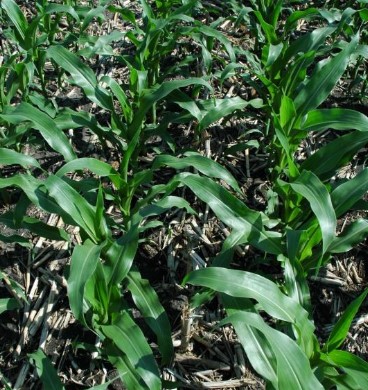Continuous corn is a "three strikes and you’re out" situation. And the first strike is automatic – high residue volume. This is how a farmer recently described it to me.
Making continuous corn work means knowing what you are up against. First, realize that the yield drag for continuous corn can range from 0% to 30% but is typically between 5% and 15%. Yield drag has been associated with cooler and wetter soils, nitrogen (N) immobilization, increased disease risk, and allelopathy – all of which are influenced by corn residue volume.
Tips to avoid strikes 2 and 3 with continuous corn:
- Location: fields that are naturally well drained or have extensive tile drainage systems are better suited for continuous corn. These field types will dry out more quickly, helping avoid costly spring planting delays. Also choose fields that are the most productive and allow the more intensive management needed for success.
- Stand establishment: seed placement is critical for uniform spacing and emergence. Just because there is greater residue doesn’t mean residue cleaners need to be set more aggressively. Adjust residue cleaners to move residue and not soil. High residue volumes can change planter performance and therefore how planter adjustments should be made. Make sure furrow opening and closing functions are working well.
- Hybrid selection: choose hybrids that are targeted for high residue situations, have a strong, defensive disease package, and have excellent seedling vigor. Plan for resistance management of transgenic traits by rotating sources of insect protection.
- Planting conditions and seeding rates: a slight seeding rate increase of 10% may offset stand establishment problems often realized with continuous corn. In southern Minnesota emergence fell 1% for every 10% increase in surface residue. Target planting when soil temperatures are continuously above 55oF to decrease risk of poor germination and seedling development.
- Soil fertility: continuous corn requires 30 to 50 pounds per acre more nitrogen than corn following soybean. Consider starter fertilizers but don’t expect a positive response in every situation. Response to starter N will be dependent on how much N is immobilized by residue decomposition and how much soil N mineralization occurs. High and very high phosphorus (P) and potassium (K) testing soils will have less response to starter fertilizers.
- Disease management: seed treatments can be used to protect seedlings from root and shoot infections. Make in-season decisions on foliar fungicides based on hybrid selection, environmental conditions, and presence of foliar diseases. Foliar fungicides should be used to protect the ear leaf and leaves above the ear leaf from leaf diseases during the grain fill period.
- Insect management: seed treatments can protect the seed and seedling from insect pests such as wireworms, seedcorn maggots, white grubs, and slugs which can be more problematic in heavy residue situations. In-season insects such as corn rootworms and European corn borers may be problematic, especially for non-transgenic hybrids. Consider insect resistance management when developing management plans.
- Manage residue: at harvest make sure that corn residue is evenly distributed across the harvest width. Create a seedbed that is residue free, preferably by using strip-tillage. Strip-tillage will warm up and dry out faster than a no-tillage situation while providing the soil health benefits of residue cover. Most research shows that application of liquid N will not enhance the rate of corn residue breakdown.
